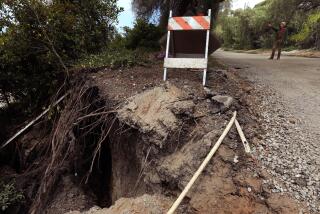Pesticide Spraying Near School Worries Parents, Teachers
Just across the fence from Amesti Elementary School on California’s Central Coast, strawberries and raspberries grow in some of the world’s most fertile farmland.
But the children at Amesti don’t chase errant soccer balls onto that field when ominous warning signs go up, and plastic tarpaulins cover the rich earth.
Fall is the season for methyl bromide, a highly effective but controversial pesticide, and the latest battleground between chemical-dependent agriculture and urban sprawl.
Fall is also the season, say many of Amesti’s teachers and parents, for a rash of strange ailments that have plagued the school for years.
“They are hard to pinpoint because they are flu-like symptoms, or they are headaches, or they are nosebleeds, or things that could be anything,” says second-grade teacher Corinne Walcott. “When there are methyl bromide applications, children and teachers have experienced things like numbness in their faces for as long as several weeks.”
It was years before the teachers began suspecting methyl bromide. Until then, they considered the illnesses isolated problems, a normal part of the school experience.
Then they looked at the symptoms of methyl bromide poisoning. Alarm bells rang.
Blurred vision. Weakness. Dizziness. Nosebleeds. Headaches. And, in more severe cases, pneumonia, paralysis, heart problems, fetal damage and ultimately death.
“My portable [classroom] is right by these raspberry fields,” says second-grade teacher Karen Kite. “The wind comes directly from the field right into my windows. Someday I would like to have a choice to start a family, but these things are reproductive poisons.”
When the school year started--along with the pesticide applications--the teachers decided they’d had enough. They talked to equally alarmed parents.
The group approached the Santa Cruz County agricultural commissioner and asked for a hearing. A scheduled Sept. 20 application was delayed, but ultimately state and local authorities gave the go-ahead.
On Sept. 27, grower Will Garrouette began injecting methyl bromide into the field next to Amesti.
And on Sept. 27, about 270 of the school’s 650 students stayed home. In subsequent applications, the number of absences was around 100.
Jim and Lorraine Scott-Behrends, with three children at Amesti, helped organize parents.
“If people are getting sick at this school, my bottom line is that I am putting my children at risk here,” Jim says. “Methyl bromide is a neurotoxin. We don’t know the effect, especially with a child, of a long-term exposure for six hours a day.”
But the boycott angered school officials. They lost money--tens of thousands of dollars--in state reimbursement because of the absences.
They felt that teachers were fanning unfounded hysteria in children and parents.
“It’s what it does to the kids,” says Terry McHenry, assistant superintendent of the Pajaro Valley Unified School District. “They’re scaring kids about being outside. They’re scaring them about coming to school.”
The real issue, McHenry says, is an increasingly urban population uneasy with rural lifestyles.
“You look at this county--half of it is covered with strawberries and other crops,” he says. “They’re saying you can’t live in a farm community.”
What testing has been done shows no exposure above California’s maximum level of 210 parts per billion, officials say.
A test of Amesti teachers after an Oct. 18 spraying found normal levels of methyl bromide in their bloodstream, say Santa Cruz County health officials.
The farmer using methyl bromide dismisses the concern of parents and teachers.
“We’ve worked around it all of our lives,” Garrouette says. “It’s not nearly as bad as everyone thinks.”
Led by Gov. Pete Wilson, the state government has continually fought efforts to ban or further restrict methyl bromide. The governor has said a ban could cost the state 10,000 jobs and nearly $350 million in crop losses.
But the pesticide can be deadly if misused. At least 15 deaths have been attributed to methyl bromide since 1982, all from people who entered fumigated buildings. The state finally banned such uses for the chemical.
In Castroville, across the Monterey County border from Watsonville, tarpaulins covering a methyl bromide-injected field ripped away, and the chemical gas drifted into neighboring homes. In Ventura, residents and operators of a day-care center complained of headaches, stomachaches and other symptoms after methyl bromide applications. In 1984, a cloud of the gas forced the evacuation of 1,500 people in Stanislaus County.
The United Farm Workers union has conducted a battle against the pesticide, which it fears is poisoning workers sent into the fields.
“More than 800 elementary schools and licensed day care centers are located within a mile and a half of fields where methyl bromide is used,” says Marc Grossman, a UFW official. “And pesticide enforcement is a joke in California.”
California Department of Pesticide Regulation officials bristle at that charge. Where’s the proof, they ask.
Levels of methyl bromide found around Amesti, for instance, were at 50 to 70 ppb, well under the state standard.
“We find it difficult to believe there are illnesses at those levels,” says department spokeswoman Veda Federighi.
Lorraine Scott-Behrends says no existing studies show what will happen to human beings, especially children, after long-term exposure to methyl bromide.
“The tobacco industry will still tell you that cigarette smoking won’t kill you. And how long did they tell us DDT was safe?” she says. “Just because they’re saying methyl bromide is safe, I’m not willing to test that with my children’s health.”
An irony in the debate is that methyl bromide production in the United States is banned as of 2001 under an international treaty--not because of poisoning, but because the gas is destroying the world’s ozone layer. Methyl bromide critics fear, however, that existing stocks will continue to be used for years--and that chemical companies will find a loophole or a way to delay implementation of the treaty.
In the field next to Amesti, farm supervisor Jaime Hernandez sees the issue in simple terms.
“If you don’t use the bromide, there’s no harvest. And then there’s no work,” he says.
Sitting in a car outside the school, where he’s picking up his two little sisters, Eisbain Herrera also sees the issue in simple--but opposite--terms.
“Not with a lot of little kids around,” Herrera says, shaking his head. “I don’t think it’s safe.”
More to Read
Sign up for Essential California
The most important California stories and recommendations in your inbox every morning.
You may occasionally receive promotional content from the Los Angeles Times.






